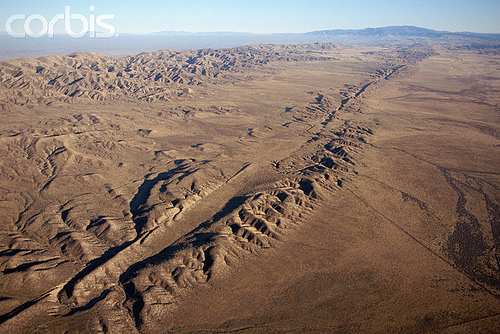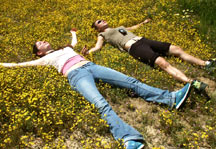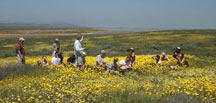

Aldebaren Occultation Images for your Lab Project
 Astronomical Motivation:
Astronomical Motivation:
The special feature of this semester's Field Astronomy class is a lunar occultation of the nearest star cluster to our solar system - the Hyades - in Taurus. The special treat is the occultation of the brightest star than can be occulted by the moon: Aldebaren. It is a 1st magnitude red giant star and the star is near enough and large enough that when we videorecord the event, we should see a noticable slope downward from the moment of the first fading to the final moment of the last bit of star winking, taking a few tenths of a second. Aldebaren is 65.2 lyr from Earth, and the Hyades is behind Aldebaren at 151 lyr away.. This will allow us to do an approximate  calculation for the diameter of the star, and do some interesting calculations with that. Of course, a secondary motivation is to get to a very dark and pristine site far from city lights so we can study the late winter Milky Way skies. In Spring, the constellation of Orion is best placed high in the southwestern sky, and is home to the most beautiful star formation region in the sky - the Orion Nebula complex. - rich in star formation regions, open star clusters, emission nebulae, dust nebulae, and a wide variety of different types of stars in their various stages of evolution.
calculation for the diameter of the star, and do some interesting calculations with that. Of course, a secondary motivation is to get to a very dark and pristine site far from city lights so we can study the late winter Milky Way skies. In Spring, the constellation of Orion is best placed high in the southwestern sky, and is home to the most beautiful star formation region in the sky - the Orion Nebula complex. - rich in star formation regions, open star clusters, emission nebulae, dust nebulae, and a wide variety of different types of stars in their various stages of evolution.
Occultation Predictions Sheet and full info sheet for instructor
A Comet
Comet 41P Tuttle/Giacobini/Kresak will be in the late evening sky in Leo, fading to about 7th or 8th magnitude but still good to photograph, and a decent fuzzball in the telescopes perhaps with a tail as well.
Our Site: Carrizo Plain National Monument
This is one of my favorite places in California, for its stark vistas, few people, dramatic mountains and plains, and in March, for beautiful wildflowers. We've been to Carrizo Plain many times over the years for field astronomy classes. See the following images from our Astro 28K trip in 2004, our Astro 28R trip in 2006, our Astro 28K trip in 2008, our Astro 28K trip in 2012, and Astro 28R in 2014.
|
Here's a GoogleEarth of our campsite. We're 1.14 miles above the obvious gate you'll go through at Selby Ranch. See the map packet I handed out to get you to this small scale map above |
 During the daytime, we'll have talks on the evolution of the inner planets of our solar system, which planets show thin crusts and faulting, and show examples for our planet Earth. Carrizo Plain is one of the best sites on Earth to see such clear evidence for recent and dramatic faulting. We'll discuss the chemistry of the inner planet crusts, comparing them to what we see at Carrizo Plain's Soda Lake and in the sediments near our campsite. We may also journey along the San Andreas fault through the convoluted hillsides, if the road conditions are dry.
During the daytime, we'll have talks on the evolution of the inner planets of our solar system, which planets show thin crusts and faulting, and show examples for our planet Earth. Carrizo Plain is one of the best sites on Earth to see such clear evidence for recent and dramatic faulting. We'll discuss the chemistry of the inner planet crusts, comparing them to what we see at Carrizo Plain's Soda Lake and in the sediments near our campsite. We may also journey along the San Andreas fault through the convoluted hillsides, if the road conditions are dry.  Our campsite will be high in the Caliente Mountains, with a dramatic overlook of the Plain and Soda Lake.
Our campsite will be high in the Caliente Mountains, with a dramatic overlook of the Plain and Soda Lake.
 There is no water or facilities at Carrizo Plain. It's a wildlife refuge more than a tourist destination - which I like! We'll be "roughing it" at our campsite. Be sure to bring enough water for yourself. I'll bring water for our outdoor kitchen and group clean up needs. There is a (unappetizing and poor for astronomy) campground a couple of miles from us, which usually has water we can get for cleaning, and possibly drinking but don't count on that. There is a small visitors center - the Goodwin Visitor's and Education Center - which we'll also stop at during the day once or twice, and has regular bathrooms.
There is no water or facilities at Carrizo Plain. It's a wildlife refuge more than a tourist destination - which I like! We'll be "roughing it" at our campsite. Be sure to bring enough water for yourself. I'll bring water for our outdoor kitchen and group clean up needs. There is a (unappetizing and poor for astronomy) campground a couple of miles from us, which usually has water we can get for cleaning, and possibly drinking but don't count on that. There is a small visitors center - the Goodwin Visitor's and Education Center - which we'll also stop at during the day once or twice, and has regular bathrooms.
Check back later for more updates to this page. There is no campground fee for this instance of Astro 25, but there will be a modest meal fee for my buying, cooking, and preparing your breakfasts and dinners.